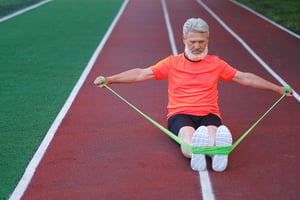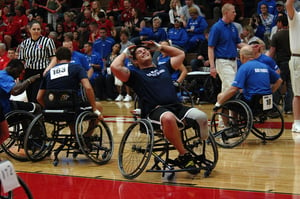It may be hard to believe, but some of the activities that you love may actually be causing you...
Don't Sit Still!: Exercising with Limited Mobility
Dig back into your childhood memory, and you'll recall your mother telling you to stop fidgeting and sit still. (Or maybe you said that to your own kids!) Youth and its boundless energy make young people into seemingly perpetual motion machines. Yet as we age, the inevitable slowdown takes place. We need to consciously make an effort to be active.
The Problem of Limited Mobility
This becomes particularly difficult when mobility becomes limited due to illness or injury. With the onset of disabilities, physical and non-physical such as memory issues, even routine activities become challenging. The temptation to become inactive can be overwhelming.
This leads to numerous health risks. The Centers for Disease Control and Prevention (CDC) states that disabled adults have a threefold chance of experiencing major diseases like cancer, stroke, cardiac issues, or diabetes. On the flip side, the CDC says disabled people who engage in aerobic exercise can cut disease risk in half compared to those who are inactive.
What's Recommended?
 The CDC recommends both aerobic and strength activity for disabled adults to get the most health gains. This prescription stipulates at least 150 minutes of aerobic movement per week like walking, even if a cane or walker is needed. Wheeling oneself in a wheelchair counts, too.
The CDC recommends both aerobic and strength activity for disabled adults to get the most health gains. This prescription stipulates at least 150 minutes of aerobic movement per week like walking, even if a cane or walker is needed. Wheeling oneself in a wheelchair counts, too.
As for strength training, using barbells might not be the best for everyone. Yoga, resistance bands, or isometric exercise can be terrific alternatives.
Of course, if one can do more vigorous exercise, that's even better. However, in all cases, a doctor's visit must precede the start of a new exercise program. This will ensure that the exercise plan will help rather than make things worse. A doctor can also provide information on exercise alternatives.
Walking Not on the Menu
 Mobility limitations that disqualify walking as an option need not be a barrier to getting exercise. For example, many pools now provide lifts for disabled swimmers. Also, gyms offer exercise machines that work the upper body only. For the more energetic types, wheelchair sports are more popular than ever.
Mobility limitations that disqualify walking as an option need not be a barrier to getting exercise. For example, many pools now provide lifts for disabled swimmers. Also, gyms offer exercise machines that work the upper body only. For the more energetic types, wheelchair sports are more popular than ever.
It's All in Your Head
Disabled or not, one thing familiar to many considering an exercise program is getting started. Here are some tips to get moving and
staying active:
-
Find an Exercise Buddy

When exercise becomes a social activity, there is a double benefit. First, socializing when exercising is fun and distracts from the uncomfortable moments of exertion. Second, being accountable to another person helps to maintain a consistent exercise schedule. It's too easy to skip exercise when trying to go it alone.
-
Watch TV or Listen to Audio
Sometimes diverting attention from straining muscles can help make an exercise program successful. Watching a favorite show or listening to audio can actually cause one to look forward to exercising. Looking forward to the next exciting TV episode or audiobook chapter can be a great motivator to maintain a consistent exercise schedule.
-
Competitive Activity
Nothing gets the excitement up like a good competition either between individuals or groups. Committing to participate becomes a motivator in itself. The congenial pressure to honor a commitment makes the activity a more regular part of life's routine.
-
Part of a Passion
Having an activity that is a passion or provides a feeling of accomplishment can be a perfect motivator. Gardening may be the thing for one person, while for another, it might be biking. In both cases, the enjoyment of the activity can make it a joy rather than a painful obligation.
Get Out There and Do It!
Being active is an option for all, no matter what the individual limitations. The real obstacle to more healthy activity is attitude. Adopting practical tactics to manage mental barriers will pay off not only in reduced disease risk but also in the likelihood of feeling better day-to-day.






